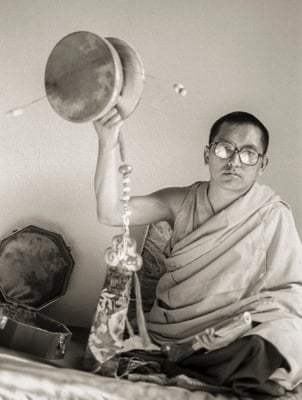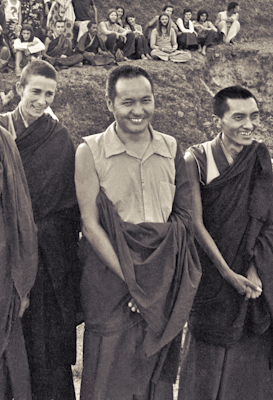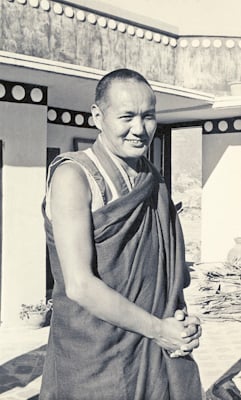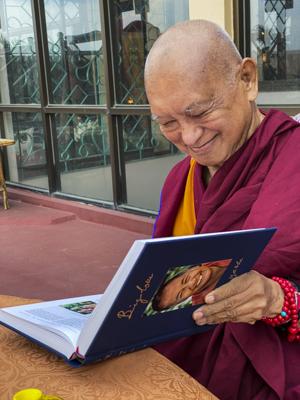Dear Friends,
Thank you for your interest in LYWA’s monthly eletters. Please share this one with anybody you think might be interested.
Big Love: The Life and Teachings of Lama Yeshe is on its way by ocean freight to our six global distribution points. Shipments to Singapore and New Zealand are arriving before the end of April; recipients will be hearing about distribution soon. The shipment to Australia is due to arrive the first week of May, and books will be mailed to recipients shortly thereafter. The Boston shipment is due to arrive in the middle of May, and shipments to the UK and France arrive around the end of May.
If you have not yet ordered your copy you can do so here, and soon you will be enjoying reading your copy as much as Rinpoche is enjoying his. Thank you, and please let us know if we can do anything for you.
Advice from Lama Zopa Rinpoche for the Coronavirus
Recently, Ven. Roger Kunsang, Rinpoche’s assistant and CEO of the FPMT, wrote:
Dear Friends,
These are challenging times with COVID-19. It brings many serious challenges to everyone, like the world has never seen before. It is important that we support our FPMT family as much as we can.
This is the reason that Rinpoche is offering these regular teachings, lungs and transmissions by video. They are to protect us as well as to help us to “use” the situation, to make it positive, to transform it into Dharma. These teachings are to help us use the situation to our own and others’ advantage, to not leave the teachings as just theory but to actually put the teachings of the Buddha into practice.
Rinpoche is teaching every other day on compassion, emptiness and lojong (thought transformation) to help us see how the Dharma gives us the ability to deal with the huge challenges we face; to see how the Dharma gives us the strength, clarity and compassion to manage these difficult circumstances. Rinpoche’s teachings come from His own deep experience of the Dharma, which inspires our own minds and gives us the strength and courage we all need in these difficult times.
Centers are already helping their community to connect with Rinpoche’s teachings—thank you! Please continue to emphasize the importance of these special teachings from Rinpoche and to make them available through your network—it really is the best way to support your community.
In addition to the powerful Dharma work Rinpoche is giving us, in these videos the young and old monks also tell the story of Kopan Monastery.
Kopan is fifty years old this year! Rinpoche has been teaching the annual one-month November meditation course there for that long! Kopan is the bedrock of the FPMT organization, so hearing its story via these videos is a good way for us all to understand and to connect more deeply with our organization.
The videos, together with transcripts and MP3 files, are available on FPMT.org to help you navigate this wealth of resources, each video is provided with a brief introduction to the content in English, French, Italian, Spanish, Russian and Chinese.
Thank you!
Sincerely
Roger Kunsang
(Lightly edited by LYWA.)
From the Video Archive: Transforming Your Mind by Practicing Dharma
Lama Zopa Rinpoche gives this beautifully inspiring teaching about Jetsun Milarepa, the great enlightened Tibetan meditator who lived in the 11th century and promised that just by thinking and saying his name, blessings will be received. Rinpoche recounts the incredible story of Milarepa's life and describes how Milarepa realized through retreat and meditation the importance of depending on Dharma alone to respond to any and all mental and physical challenges in life. When faced with relentless hardship and despair, Milarepa practiced loving kindness and remembered impermanence to transform his mind beyond suffering while creating countless causes of happiness and ultimate enlightenment. In the same way, we can free our minds and transform our lives by practicing Dharma. Rinpoche gave this teaching at the Mahayana Buddhist Association (Cham Tse Ling) in Hong Kong in 2003. Video produced by Elaine Moore.
Visit and subscribe to the LYWA YouTube channel to view dozens more videos freely available from our archive. See also the FPMT YouTube channel for many more videos of Lama Zopa Rinpoche’s teachings.
On the LYWA Podcast: Dharma in Daily Life
When you look at people, when you relate with them, if you look at their mind and how their life is motivated, you can see how much they're suffering and you feel unbearable.
-Lama Zopa Rinpoche
 This month's podcast is an extract from a series of teachings given by Kyabje Lama Zopa Rinpoche prior to conferring a chöd initiation at Maitripa College, Portland, Oregon, in June 2009. In this teaching, Rinpoche shows us how to examine each of our regular daily activities and to see whether we are motivated by Dharma or, as is more likely, motivated by worldly goals. We might not like what we find but at least we know enough to look because we have met the Dharma through the kindness of our gurus. Rinpoche reminds us that the vast majority of people living in the world have not met the Dharma like we have. They have no idea that their endless efforts to find happiness are only creating more causes for even more suffering. Contemplating their situation intensifies our practice of compassion for them and our engagement with bodhicitta for their sake. You can read along with the unedited transcript here on our website.
This month's podcast is an extract from a series of teachings given by Kyabje Lama Zopa Rinpoche prior to conferring a chöd initiation at Maitripa College, Portland, Oregon, in June 2009. In this teaching, Rinpoche shows us how to examine each of our regular daily activities and to see whether we are motivated by Dharma or, as is more likely, motivated by worldly goals. We might not like what we find but at least we know enough to look because we have met the Dharma through the kindness of our gurus. Rinpoche reminds us that the vast majority of people living in the world have not met the Dharma like we have. They have no idea that their endless efforts to find happiness are only creating more causes for even more suffering. Contemplating their situation intensifies our practice of compassion for them and our engagement with bodhicitta for their sake. You can read along with the unedited transcript here on our website.
The LYWA podcast contains hundreds of hours of audio, each with links to the accompanying lightly edited transcripts. See the LYWA podcast page to search or browse the entire collection by topic or date, and for easy instructions on how to subscribe.
WHAT'S NEW ON OUR WEBSITE
 The Bodhisattva Vows, a previously unpublished teaching by Lama Yeshe, has been posted to our website this month. This is the second part of a teaching on bodhicitta given at the Sixteenth Kopan Meditation Course in 1983. It was Lama's last public teaching before he passed away in March 1984, so it has a special significance. Author Adele Hulse writes in Big Love: “Lama’s last talk summed up everything he had ever wanted students to learn.” You can read an excerpt in our e-letter below.
The Bodhisattva Vows, a previously unpublished teaching by Lama Yeshe, has been posted to our website this month. This is the second part of a teaching on bodhicitta given at the Sixteenth Kopan Meditation Course in 1983. It was Lama's last public teaching before he passed away in March 1984, so it has a special significance. Author Adele Hulse writes in Big Love: “Lama’s last talk summed up everything he had ever wanted students to learn.” You can read an excerpt in our e-letter below.
Also new this month:
- Transforming the Adverse Conditions of the Coronavirus into the Path, a supplication composed by Khadro-la (Rangjung Neljorma Khadro Namsel Drönme) on March 30, 2020, at the request of friends around the world. Translation and notes by Fabrizio Pallotti. The prayer is freely available for download as a PDF, kindly produced by Piero Sirianni.
- The Cycle of Death and Rebirth: Lama Yeshe discusses cyclic existence in this excerpt from a teaching given during the Seventh Kopan Meditation Course in 1974.
- Introduction to the Kalachakra Initiation: This excerpt is from an introductory talk given by Lama Yeshe in Bodhgaya, India, in January 1974. The teaching was requested by Western students who had traveled to Bodhgaya to receive the Kalachakra initiation from His Holiness the Dalai Lama.
- You Will Meet Him Again in a Different Form: A student wrote that her son had just died. Rinpoche explained that the cycle of death and rebirth continues until we attain buddhahood and advised that cherishing others brings both temporary and ultimate happiness.
- Opening the Wisdom Eye: In this letter to the director of a school, Rinpoche advises the importance of helping children develop wisdom and compassion, so they can bring happiness and benefit to other sentient beings.
- His Holiness is the Supreme Leader: Rinpoche sent this message to a geshe who wanted to arrange pujas in Tibet for the long life of His Holiness the Dalai Lama.
- The Four Harmonious Brothers: Advice about construction of a statue of the four harmonious friends. The four animals, an elephant, a monkey, a rabbit and a bird, lived in the forest and spread harmony to the other animals, creating peace and prosperity in the whole kingdom.

Director
THIS MONTH'S TEACHING: the bodhisattva vows
 At the outset I mentioned two ways of taking the bodhisattva vows. The first is the wishful way, wanting to develop the mind that wishes to help other sentient beings as much as possible, realizing that to help others in the best way you have to develop toward liberation as quickly as possible, and trying to maintain that motivation continuously in this, the next and all future lives. You have no doubt that this is the best way to go, but you may feel, with respect to actually practicing the bodhisattva path, that you cannot keep the sixty-four vows or engage in the extensive deeds right now. Think, "I shall do as much as I can, but I cannot take the full commitment at the moment." This way there is no heavy vow and you do what you can.
At the outset I mentioned two ways of taking the bodhisattva vows. The first is the wishful way, wanting to develop the mind that wishes to help other sentient beings as much as possible, realizing that to help others in the best way you have to develop toward liberation as quickly as possible, and trying to maintain that motivation continuously in this, the next and all future lives. You have no doubt that this is the best way to go, but you may feel, with respect to actually practicing the bodhisattva path, that you cannot keep the sixty-four vows or engage in the extensive deeds right now. Think, "I shall do as much as I can, but I cannot take the full commitment at the moment." This way there is no heavy vow and you do what you can.
If you take the vows the second way, you think, "I shall keep the root and branch vows and actualize the six perfections as much as I possibly can from now until my death, forever." This is the sort of strong determination that you make.
Thus, there are two ways to take the bodhisattva vows and both are acceptable. The first way is not a kind of lie. There is no doubt in your mind that the altruistic mind of loving kindness is really your path; that bodhicitta is your deity, your Buddha, your Dharma, your Sangha, your bible—your Buddhist bible, your Hindu bible, your Muslim bible, your all world religions’ bible. This is the way you should think. When you take the vows you don't have to be nervous about breaking them because you have said, "I'll do as much as I possibly can," and you have not promised something that you can't do. You shouldn't feel that by taking the vows this way you are somehow cheating.
Many people have a commitment from certain initiations to practice the six-session guru yoga each day, in which they renew or make their bodhisattva vows clean-clear. Those who don't have this particular practice can still do the same thing. Six times a day, for just a minute, you can simply remember your commitment to the development of bodhicitta. You don't have to do anything dramatic, like Muslims bowing to Mecca. Wherever you are—standing or sitting or when you go to bed—just remember bodhicitta. That's good enough. Actually, there is a traditional way of doing this six times a day, with a visualization of the buddhas and bodhisattvas of the ten directions in front of you and a prayer to be recited, but there is no necessary requirement to do this. If you want to do this, it's good for reminding yourself about bodhicitta, but the other way is easier when you're amongst ordinary people.
When you get up in the morning, sit on your bed for a minute or two and think, "Today I shall actualize bodhicitta and make my life meaningful for others." That's all. Then take a shower, have breakfast and go off to work. You get a lunchbreak, so after you've finished your sandwiches and coffee, just sit for a minute or two and renew your motivation. The same thing before you go to bed. So, according to your daily life, you can find six times to do this short practice. It is simple isn't it, and it doesn't conflict with your culture. It's no big deal. But formal meditation, sitting cross-legged, is a big deal, isn't it? You cannot just drop into the full lotus wherever you are. And you can't mix sleep with formal meditation, but you can mix bodhicitta with ordinary sleep.
Thus, bodhicitta is the most worthwhile path. No argument, no worry about this. It is completely the right thing, something we can practice for the rest of your life. Really the best. Forget about tantra. Of course, if your tantric practice helps you grow bodhicitta, do it, but if you don't forget your bodhicitta from now until the time you die, you are totally guaranteed freedom from a bad rebirth. I can promise you that you'll not be reborn in an African desert! The mind that has bodhicitta is incredibly rich, an unbelievably rich mind. There is no way a person with bodhicitta has to go without water—a rich mind makes us rich. That's why I say the bodhisattva path is the most comfortable path to enlightenment. It’s very comfortable and very scientific. You don't have to worry that you're not understanding it or whether it's working or not. It's clean-clear; it's perfect.
Lama Yeshe gave this teaching during the Sixteenth Kopan Meditation Course held at Kopan Monastery, Nepal, in November–December 1983. This was one of Lama's last teachings before he passed away in March 1984. Edited by Uldis Balodis. You can find the whole teaching here on our website.





























